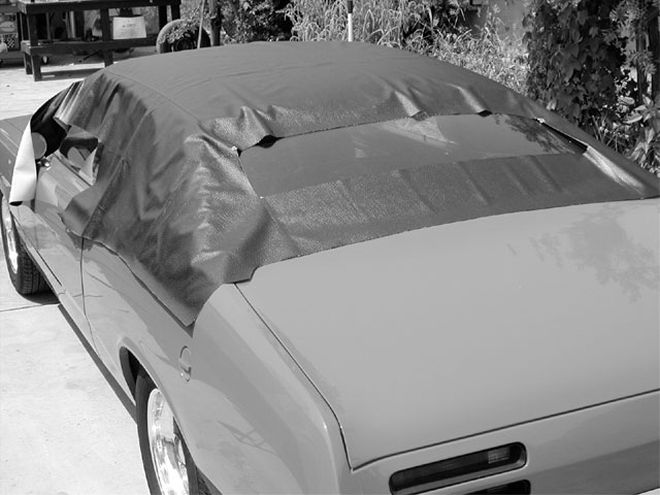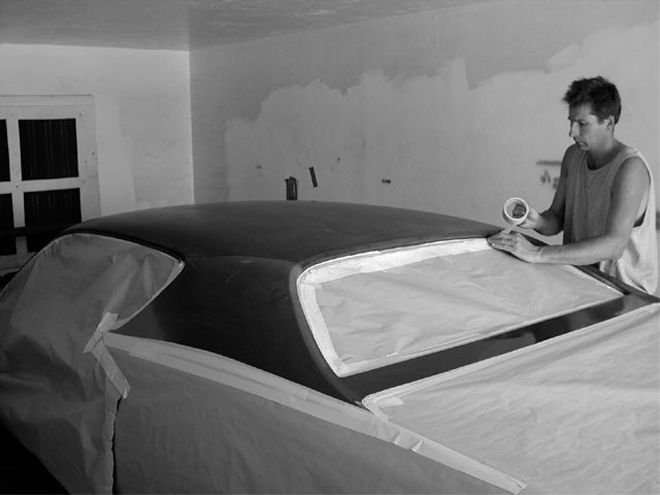
 For our '71 R/T, we tapped Year One for a vinyl-top kit PN KT157BLK. Made in the original Boar grain fabric with 46 1/2 inches between the dielectrically sewn seams, it's a dead ringer for original equipment. The top was laid over our Duster so the sun could soften the material and ease any shipping creases. Lightly ironing the material from the backside will accomplish the same result.
For our '71 R/T, we tapped Year One for a vinyl-top kit PN KT157BLK. Made in the original Boar grain fabric with 46 1/2 inches between the dielectrically sewn seams, it's a dead ringer for original equipment. The top was laid over our Duster so the sun could soften the material and ease any shipping creases. Lightly ironing the material from the backside will accomplish the same result.
Though rarely seen on new cars today, in the musclecar era, vinyl tops were a popular option. By the mid-'70s and into the '80s, however, the attractive vinyl top had degenerated into a bloated excess of gaudy padded landau, disappearing shortly afterwards in shame. Many of the classic Mopar body styles, on the other hand, looked great with a fabric-covered roof. Our '71 Charger R/T left the factory wearing a Boar grain vinyl top in basic black. It nicely complements the sweet lines of the Charger, contrasting with the GY-9 paint, and enhancing the stripes and hood blackout.
Our top had been replaced 10 years prior, and while it was still in good shape, minor surface rust in the roof was starting to lift the fabric at various points below the vinyl covering. Since we're in the process of a minor rebuild on this car, replacing the top was on our to-do list. So, the old top was peeled off to find the source of its troubles. Poor prep under the old top consisted of a rough sanding of the original glue, and a shot of cheap lacquer primer. The porous primer was lifting, and the vinyl top was losing its grip to the roof as a result. Fortunately, the rust was only in its formative stages, with most of the problem stemming from the lacquer primer peeling from the steel of the roof. We stripped and treated the entire roof, and applied several coats of epoxy primer to create a solid base for a new top.
 The roof of the Charger was masked off to prevent getting glue on the paint. The old top and trim had already been removed, the glue stripped off, and the roof shot with PPG epoxy primer. Corrosion can be a problem under a vinyl top, so it is important to have a clean, rust-free, and well-protected surface.
The roof of the Charger was masked off to prevent getting glue on the paint. The old top and trim had already been removed, the glue stripped off, and the roof shot with PPG epoxy primer. Corrosion can be a problem under a vinyl top, so it is important to have a clean, rust-free, and well-protected surface.
New vinyl tops are cataloged by Year One for most any muscle-era Mopar. We called in for a replacement and were surprised to find that an authentic reproduction top can be purchased for little more than the cost of a cheap aftermarket "universal" top. Other than the authentic grain and seams, there are other big differences between these tops and the typical upholstery shop special.
The top we received from Year One was constructed much like the original-made from a heavy-weight vinyl of the correct grain, with a thin cloth backing. Most "replacement grade" tops come with a soft felt filler backing, which lends a puffy look to the top-quite different from the factory-delivered product. Year One's top for the '71 Charger comes fully assembled, including the seams around the lower edge of the rear window, while most replacement-grade tops come with a separate strip for this area, which needs to be sewn on.
Installing a vinyl top is a finesse job. In fact, Year One strongly advises a professional for the installation. We feel like pros around here, so we weren't daunted; quite a few installs over the years help build confidence. Unfortunately, Bolig wasn't in town to lend a hand when the time came to get it done. The install should be considered a two-man job, at least during the initial placement. Front to back, the replacement took an honest day's work, but the quality good looks are going to be around for years to come.